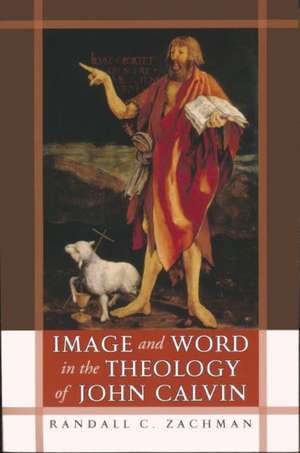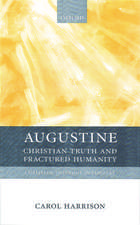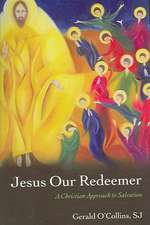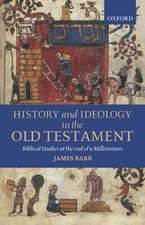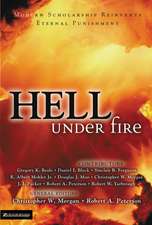Image and Word in the Theology of John Calvin
Autor Randall C. Zachmanen Limba Engleză Paperback – 14 aug 2009
In his groundbreaking new study of the Swiss reformer, Randall C. Zachman reveals and analyzes John Calvin's understanding of image and word both comprehensively and chronologically, with attention to the way that each theme develops in Calvin's theology.
For most scholars, John Calvin (1509-1564) insisted on the essential invisibility of God in order to deny that God could be represented in any kind of visible image. This claim formed one of his foundational arguments against the display of man-made images in worship. Given the transcendence of God, Calvin rejected the human attempt to create signs and symbols of GodÕs presence on earth, especially the statues, images, and paintings present in Roman Catholic churches.
Zachman argues, in contrast, that although Calvin rejects the use of what he calls "dead images" in worship, he does so to focus our attention on the "living images of God" in which the invisible God becomes somewhat visible. Calvin insists that these images cannot rightly be contemplated without the Word of God to clarify their meaning; we are only led to the true knowledge of God when we hold together the living images of God that we see with the Word of God that we hear. This combination of seeing and hearing pervades Calvin's theology, from his understanding of the self-revelation of God the Creator to his development of the self-manifestation of God the Redeemer in Jesus Christ. According to Zachman, Calvin maintains the same linking of seeing and hearing in our relationships with other human beings: we must always hold together what we see in others' gestures and actions with what we hear in their words, so that the hidden thoughts of their hearts might be manifested to us.
Zachman's nuanced argument that Calvin holds image and word, manifestation and proclamation, in an inseparable relationship is relevant to all the major themes of Calvin's theology. It constitutes a highly significant and surprising contribution to our knowledge of the Reformation and an invitation to further study of theological aesthetics.
"Randall C. Zachman's Image and Word in the Theology of John Calvinmay well become the standard introduction to the theology of John Calvin. Better than any book I know, Zachman makes sense of Calvin's work and methods while capturing Calvin's religious sensibilities in a way no other does. This may be the book that finally demolishes an older image of Calvin that much of the Calvin scholarship has been chipping away at for the last thirty years. Zachman's fresh reading of Calvin makes a true scholarly contribution that could well shape Calvin studies--and broader late medieval and early modern studies that bump into Calvin--for the next generation." --Thomas J. Davis, Indiana University-Purdue University IndianapolisFor most scholars, John Calvin (1509-1564) insisted on the essential invisibility of God in order to deny that God could be represented in any kind of visible image. This claim formed one of his foundational arguments against the display of man-made images in worship. Given the transcendence of God, Calvin rejected the human attempt to create signs and symbols of GodÕs presence on earth, especially the statues, images, and paintings present in Roman Catholic churches.
Zachman argues, in contrast, that although Calvin rejects the use of what he calls "dead images" in worship, he does so to focus our attention on the "living images of God" in which the invisible God becomes somewhat visible. Calvin insists that these images cannot rightly be contemplated without the Word of God to clarify their meaning; we are only led to the true knowledge of God when we hold together the living images of God that we see with the Word of God that we hear. This combination of seeing and hearing pervades Calvin's theology, from his understanding of the self-revelation of God the Creator to his development of the self-manifestation of God the Redeemer in Jesus Christ. According to Zachman, Calvin maintains the same linking of seeing and hearing in our relationships with other human beings: we must always hold together what we see in others' gestures and actions with what we hear in their words, so that the hidden thoughts of their hearts might be manifested to us.
Zachman's nuanced argument that Calvin holds image and word, manifestation and proclamation, in an inseparable relationship is relevant to all the major themes of Calvin's theology. It constitutes a highly significant and surprising contribution to our knowledge of the Reformation and an invitation to further study of theological aesthetics.
"With this impressive study Randall Zachman has established himself as one of the foremost Calvin scholars in the world. His earlier works--The Assurance of Faith (a study of conscience in Luther and Calvin), and John Calvin as Teacher, Pastor and Theologian--were substantial contributions to Calvin studies, but this large volume is the capstone of many years of immersing himself in the Calvinian corpus. Developing two major motifs of the living images of God the Creator and God the Redeemer, the author treats a wide variety of themes in Calvin's theology in a fresh and creative way. This is a monumental accomplishment. Written in a lively, lucid manner, this work should be of interest not only to Calvin scholars but also to a more general readership." --I. John Hesselink, emeritus, Western Theological Seminary
"Most students of John Calvin concentrate on his use of words and make of his form of religion one that can be absorbed only by listening or reading. Randall Zachman, by examining closely Calvin's constant references to living images, suggests that Calvin created a form of religion that should be absorbed by both listening and looking, revealed in both truth and beauty. His book supplies a fresh view that will be of special interest to those seeking ecumenical perspectives on Calvin's important contributions to the Christian tradition." --Robert M. Kingdon, Emeritus, University of Wisconsin-Madison
Preț: 305.50 lei
Nou
Puncte Express: 458
Preț estimativ în valută:
58.46€ • 60.91$ • 48.40£
58.46€ • 60.91$ • 48.40£
Carte tipărită la comandă
Livrare economică 03-17 aprilie
Preluare comenzi: 021 569.72.76
Specificații
ISBN-13: 9780268045012
ISBN-10: 0268045011
Pagini: 560
Dimensiuni: 157 x 234 x 33 mm
Greutate: 0.82 kg
Ediția:1st Edition
Editura: MR – University of Notre Dame Press
Locul publicării:United States
ISBN-10: 0268045011
Pagini: 560
Dimensiuni: 157 x 234 x 33 mm
Greutate: 0.82 kg
Ediția:1st Edition
Editura: MR – University of Notre Dame Press
Locul publicării:United States
Recenzii
"Randall C. Zachman's Image and Word in the Theology of John Calvinconstitutes a major revision of a longstanding assumption regarding Calvin's theology of divine self-manifestation. At the heart of Zachman's work is a reassessment of an important aspect of Calvin's theology. . . . His discussion of Calvin's understanding of divine self-manifestation by means of visions, oracles, and the 'manifestations of piety in the church' leads us away from the overly intellectualistic reading of Calvin that has characterized scholarship, and it opens up a refreshing consideration of Calvin as a theologian of experience." --Renaissance Quarterly
"Zachman has written a tour de force on the interplay in John Calvin's theology between image and word. Too often, Zachman demonstrates, people have a caricatured view of Calvin's hostility to religious iconography. Zachman argues that Calvin did have a hostility to 'dead images,' but was open to using sights and images that allowed viewers to comprehend the Word of God in different ways than hearing alone. . . . Anyone who seeks to be engaged in Calvin scholarship or Calvinist theology will have to read and engage Zachman. Essential" --Choice
"The work is focused on the relationship between the 'theologies' of manifestation and proclamation in Calvin's corpus examining Calvin's understanding of images and words, the visible and auditory, as they are woven together in the fabric of his theological oeuvre. . . . Zachman's work is a significant contribution to Calvin scholarship and must be considered for its provocative, if unconventional thesis regarding the role of images in Calvin's theology." --Sixteenth Century Journal
"Zachman's landmark work, with its copious references to Calvin's writings and attention to the historical development of his thought, provides Protestants the opportunity to alter the received view of Calvin's theology as being 'anti-aesthetic.' In doing so, he opens the doorway for a thoroughly Protestant and evangelical contribution to the burgeoning discipline of theological aesthetics that connects to both Augustine and Jonathan Edwards." --Themelios
Notă biografică
Randall C. Zachman taught Reformation and post-Reformation theology at the University of Notre Dame from 1991-2017. Since his retirement, he has moved to Lancaster, PA with his wife Carrie Call, and is now Adjunct Instructor of Church History at Lancaster Theological Seminary. He is the author of The Assurance of Faith and John Calvin as Teacher, Pastor, and Theologian, and co-editor of Conciliation and Confession (University of Notre Dame Press).
